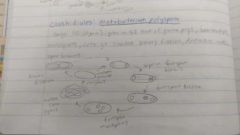![]()
![]()
![]()
Use LEFT and RIGHT arrow keys to navigate between flashcards;
Use UP and DOWN arrow keys to flip the card;
H to show hint;
A reads text to speech;
40 Cards in this Set
- Front
- Back
|
What is Bacteriorhodopsin |
Single protein light driven proton pump. Usually found in halophilic archaea. |
|
|
What are the two types of bacterial photosynthesis |
Oxygenic and Anoxygenic |
|
|
Chlorophyll |
Light absorbing pigment has a chromophore |
|
|
What type of organism haves Photosystem 1 |
Green sulfate bacteria |
|
|
Mesophile |
Organism living in moderate temperature not to cold or to hot |
|
|
Phototroph |
Organisms using light as an energy source |
|
|
Halohordopsin |
Pumps in Cl ions |
|
|
Heterotroph |
Use complex organic molecules to digest and use it for energy |
|
|
Oxidative phosphorylation |
E- carried by NADH from glycolysis and TCA cycle to the ETS and pump H+ ions out if membrane and enter ATP synthase to make ATP. |
|
|
What are the products of glycolysis |
2ATP and 4e carried by 2NADH and 2H+ and pyruvate |
|
|
What are the products of TCA |
2ATP, 16e- carried by 6NADH, 6H+ and 2FADH2 |
|
|
What products make by 2 pyruvate converted to 2 acetyl coA |
4e- carried by 2NADH, Co2 and 2H+ |
|
|
What is the total overall Yield of ATP in oxidative phosphorylation. |
38 ATP |
|
|
ETS |
Electron transport system. Carried e- across membrane and pump protons out to make gradient and use them to make ATP |
|
|
Oxidoreductase |
E- acceptor from NADH and move e- to quinos and pump 4H+ |
|
|
Terminal Oxidase |
Or also cytosome pump protons out use e- from the heme groups and make water. |
|
|
What is the total yield of Bacterial ETS for aerobic NADH |
2H20 and 16H+ |
|
|
Stromatolites |
Earliest form of life are bacterial communities. A bulbous mass of sedimentary layers of limestone (CaCo3) |
|
|
Reductive (degenerative) evolution |
Loss or mutation of DNA encoding in selected traits |
|
|
Clades |
Branching groups of related organisms. |
|
|
Lithotroph |
Use inorganic substrates as energy source. Nitrates sulfur and others |
|
|
Psychrophiles |
Grow in very cold temps like Antarctica or north pole. Temps of -20 - +10 degrees Celsius |
|
|
Hypoerthermophiles |
Organisms living in extreme hot temps above 80°C |
|
|
What is energy |
Movement of electrons use of ATP to do work |
|
|
What are 3 ways ATP can transfer energy |
Hydrolysis release phosphate Hydrolysis release triphosphate or 2 P Do phosphorylation of an organic molecule |
|
|
Electron carriersa |
NAD+ AND FAD+ |
|
|
What are the 3 main routes if glucose breakdown |
1. EMP or embden mayerhof parnas 2. ED or Entner Doudoroff 3. Penrose phosphate shunt |
|
|
Cynobacteria /phylum |
Ozygenic photrophic, have chlorophyll, thylakoids, fix co2 and N2 |
|
|
Substrate Level Phosphorylation |
Transfer of phoshate group from organic substrate to make ATP |
|
|
What is the EMP pathway |
Glucose > glucose 6-p > fructose 6-p > frutose1,6-p > G3P > glyceraldehyde 3-p > 1,3-p glycerate > 2-p glycerate > PEP > pyruvate |
|
|
What are the reactants needed to for EMP and the product yield |
2ADP + 2P ---> 2ATP + 2H20 2NAD+ + 4H+ + 4e- ---> 4e- + 2NADH + 2H+ |
|
|
What are the most well known bacteria Phyla |
Cyanobacteria. Spirochetes. Planctomycetes. Firmicutes and actinobacteria (gram +). Proteobacteria and acidobacteria (gram -) |
|
|
Which my phyla are gram + bacteria |
Firmicutes and actinobacteria |
|
|
Firmicutes phyla |
Low GC. Gram +. Rods or cocci. Common in soils and degrade plant substrates. |
|
|
Actinobacteria |
High GC. Gram +. Aerobic and are acid fast stain. Rods, filamentous sometimes cocci. |
|
|
Bacillus |

|
|
|
Mycobacterium |
Rod shape have thick cell walls with myotic acid. Species: M.tuberculosis M.leprae M.smegmatis |
|
|
Proteobacteria phylum |
5major classes. Common structure are gram - |
|
|
Alphapriteobacteria |

|
|
|
What are the 4 main Archea Phylum |
Crenarcheota Thaumarchaeota Euryarchaeota Ancient Archeal Group |

